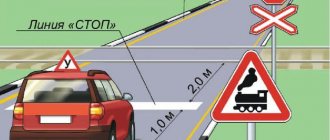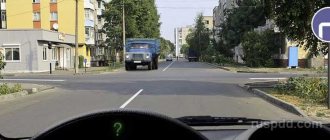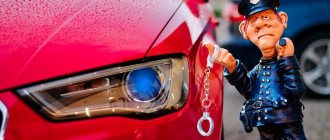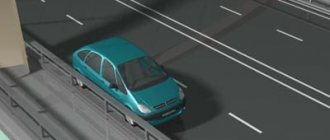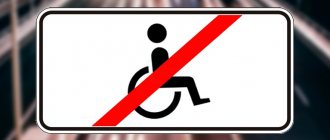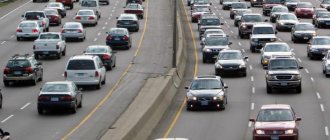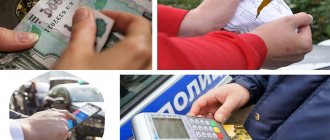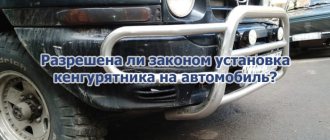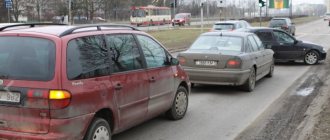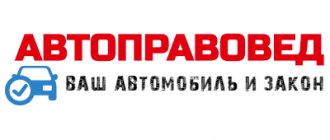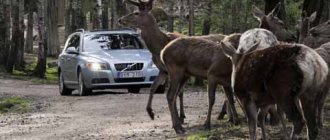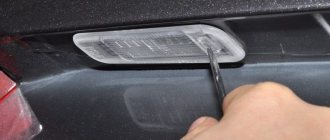Special signals are devices for producing flashing light signals and special sound signals that are installed on certain vehicles.
For the unlawful installation and use of special signals, as well as driving a vehicle on which special signals are illegally installed, administrative liability is provided in the form of a fine and (or) deprivation of the right to drive a vehicle with confiscation of the devices.
Which vehicles are allowed to have flashing orange and yellow lights installed on them?
In 2021, when using a flasher, it is important to take into account that the car must have Russian registration. If we turn to clause 11 of the main provisions for the approval of a vehicle for operation, it says that:
Quote: 11. It is prohibited to operate: “... vehicles equipped with yellow or orange flashing lights that are not registered with the State Road Safety Inspectorate of the Ministry of Internal Affairs of the Russian Federation or other bodies determined by the Government of the Russian Federation (with the exception of vehicles transporting large-sized cargo, explosive, flammable, radioactive substances and toxic substances of a high degree of danger).
It is prohibited to install flashing lights on cars that have not been registered and do not have license plates and on cars that were registered outside the Russian Federation. But there is an exception here - these are cars transporting explosive, radioactive, flammable substances, highly dangerous toxic substances and large cargo.
Training in driving vehicles with special signals
The LEADER-VICTORIA driving school trains drivers for the right to drive vehicles equipped with devices for giving special light and sound signals.
The training is intended for drivers of vehicles of category “B” to obtain the right to drive vehicles with special signals.
The training is carried out according to the program: “Advanced training of drivers of vehicles of category “B” for driving vehicles equipped with devices for giving special light and sound signals .
The course fully complies with the requirements of current legislation:
- Order of the Ministry of Education and Science of Russia dated March 1, 2018 N 161 “On approval of exemplary programs for advanced training of drivers of vehicles of relevant categories and subcategories”;
- Federal Law of December 29, 2012 N 273-FZ “On Education in the Russian Federation”;
- Order of the Ministry of Education and Science of Russia dated April 18, 2013 N 292 “On approval of the Procedure for organizing and implementing educational activities in basic vocational training programs”;
- Federal Law of December 10, 1995 N 196-FZ “On Road Safety”.
Requirements for those wishing to undergo training:
- Driving experience of at least one year;
- Copies of a Russian citizen’s passport and driver’s license;
- Medical certificate (Order of the Ministry of Health of the Russian Federation dated June 15, 2015 No. 344n);
- A copy of the document on basic education (diploma or certificate)
Where will the classes take place?
- In our training center at the address: Moscow, Borisovsky proezd 32, 3rd floor.
Duration of training:
The duration of the course is 40 academic hours (10 days).
Course fee:
| Number of trainees | Cost per student, rub. | ||
| At the ANO NMC site | On the Customer's territory | Distance learning | |
| From 5 to 10 | 6000 | 7000 | 5000 |
| From 11 to 30 | 5000 | 6000 | |
| From 31 to 50 | 3000 | 4000 | |
| Over 50 | 2500 | 3000 | |
Certificate:
Drivers who have completed training and confirmed their qualifications at the final certification are issued a Certificate valid for 5 years. Having a certificate gives you the right to drive a vehicle with installed special signals.
The form of the certificate complies with Art. 60 of the Federal Law of December 29, 2012 N 273-FZ.
Expert comment:
Citizens who want to get a job as drivers of fire trucks, ambulances or road patrol vehicles are faced with the problem that having just a driver's license of the required category is not enough for employment. The fact is that all of the above vehicles are equipped with systems for producing special sound and light signals, and in order to obtain the right to drive these vehicles, the driver must first undergo special training.
The scientific and methodological center offers training courses for driving category “B” vehicles equipped with special signals, the results of which issue a training certificate valid for 5 years. It will allow you to find a job as a driver in any special service.
When is orange flashing lights allowed?
There is a list of situations in which it is necessary to use orange flashing lights, and it is clearly stated in clause 3.4 of the traffic rules:
Quote: 3.4. A yellow or orange flashing light must be turned on on vehicles in the following cases:
- performing work on the construction, repair or maintenance of roads, loading damaged, faulty and moving vehicles;
- transportation of large cargo, explosive, flammable, radioactive substances and highly dangerous toxic substances;
- escort of vehicles transporting large, heavy and dangerous goods;
- accompanying organized groups of cyclists during training events on public roads;
- organized transportation of a group of children.
- An illuminated yellow or orange flashing light does not provide an advantage in traffic and serves to warn other road users of danger.
We draw your attention to the word “should” in paragraph 3.4 - this is an important point! If in the situations listed above, the vehicle does not have an orange or yellow flashing light, this will be considered a violation of traffic rules.
There are a number of situations when a yellow flasher should be on a car:
- Road is up;
- The road is being constructed or reconstructed;
- During road maintenance work: sweeping the road surface, washing it, removing snow;
- If the car accompanies an organized group of cyclists;
- When the tow truck is working. This applies to the loading of faulty or damaged transportable vehicles;
- On escort vehicles during the transportation of dangerous, heavy, large-sized cargo;
- On vehicles transporting toxic, large, flammable, explosive, radioactive cargo;
- During organized transportation of children on buses.
For reference! As you noticed, the traffic rules do not prohibit the use of an orange flashing light in other cases.
It is important to know that if you need to attract additional attention to your vehicle, you are allowed to turn on the yellow beacon. BUT! It will not give you any advantage on the road. But there are still positive aspects.
For example, a driver is involved in a traffic accident and needs prompt assistance from an emergency commissioner. He dials the number of the Unified Service of Emergency Commissioners, and an emergency response team arrives to him as soon as possible. Whatever one may say, our mentality is designed in such a way that any flashing lights attract the attention of other road users, and drivers, willy-nilly, slow down, and some calmly let the vehicle pass. Moreover, the emergency commissioner’s car most often has a corresponding inscription, and those who have been in an accident before and contacted the emergency commissar understand where he is rushing - to help people who are in trouble on the road! Of course, an emergency response vehicle has no advantage on the road, but it can get to the scene of an accident faster than a regular car.
The advantages of this are obvious: the emergency commissioner on site will quickly assess the current situation, take the necessary photographs and videos, after which the road can be cleared of damaged cars and debris, if any. As you know, under no circumstances should they be removed or moved until the accident has been reported in accordance with the law. And only a professional can do this in the shortest possible time: either a traffic police officer or an emergency commissioner. But since recently not all accidents require calling the traffic police, the services of an emergency commissioner in Crimea are in demand more than ever. Moreover, on the Tavrida highway there are many sections where either reconstruction or repair work is underway, so the number of accidents in such places is not encouraging.
Special signals for which installation permission is required
Special sound and light signals are installed on vehicles in cases provided for by law (clauses 1 - 3 of Decree of the President of the Russian Federation dated May 19, 2012 No. 635
).
Reference.
signals A special sound signal is a device designed to provide special sound signals of a certain spectral composition in traffic conditions. The device is not a standard component of the vehicle design as a sound signal, differing from it in the spectral composition of the sounds produced, and is installed additionally in/on the vehicle (clause 3.11, section 3 of GOST R 50574-2019).
A special light signal (flashing beacon) is a device designed to provide flashing light signals of specified colors, blinking frequency and duration of illumination in road traffic conditions. The device is not a standard component of the vehicle design as an external lighting device and is installed on it additionally (clause 3.12, section 3 of GOST R 50574-2019
).
In this case, the flashing lights of emergency services vehicles of all types must be blue. On vehicles of the State Traffic Inspectorate, FSB and VAI bodies, red beacons can be used in addition to blue flashing lights (clause 6.2.1 section 6 of GOST R 50574-2019
).
Devices for supplying special signals are installed on vehicles in the presence of color graphics on the outer surface of the vehicle and, in some cases, in their absence.
If there are special color graphic schemes on the outer surface of the vehicle, they are equipped with special signals, in particular (clause 3 of Decree of the President of the Russian Federation dated May 19, 2012 No. 635
;
section 1 GOST R 50574-2019
):
• vehicles of the fire department, police, ambulance, professional emergency rescue services, professional emergency rescue units, military police, military police of the RF Armed Forces, troops of the National Guard of the Russian Federation, investigative bodies of the RF IC, used to carry out urgent actions to protect life and health of citizens;
• special operational service vehicles of the penal system for transporting persons in custody.
In the absence of special color graphic schemes on the outer surface of the vehicle, special signals are equipped, in particular, with vehicles serving persons who are provided with state protection and persons in respect of whom state protection measures have been taken. The list of government bodies on whose vehicles special signals are installed is approved by the President of the Russian Federation (clauses 1, 2 of Decree of the President of the Russian Federation dated May 19, 2012 No. 635
;
List, approved. Decree of the President of the Russian Federation dated May 19, 2012 No. 635
).
The installation of blue, blue and red flashing lights and the installation of special sound signals require permission from the traffic police. In the registration certificate of a vehicle on which the use of special signals is permitted, a corresponding note is made (clause 2 of the Instructions, approved by Order of the Ministry of Internal Affairs of Russia dated March 31, 2014 No. 194
(hereinafter referred to as
Instruction No. 194
);
clause 21 of the Basic Provisions, approved. Decree of the Government of the Russian Federation dated October 23, 1993 No. 1090
(hereinafter referred to as
Basic Provisions No. 1090
)).
The decision to issue permits for vehicles in the absence of special color graphic schemes on the outer surface of these vehicles is made on the basis of written requests from the heads of the relevant government bodies to the Main Traffic Safety Inspectorate of the Ministry of Internal Affairs of Russia (clause 3 of Instruction No. 194
).
Are there any advantages to cars equipped with yellow flashing lights?
As we said above - NO. And even if the car is driving with a flashing yellow light, this does not give it any advantage, and you don’t have to give way.
Example: An organized group of cyclists is riding on the road, accompanied by a car with a flashing light. The driver behind the wheel is obliged, like other road users, to comply with traffic regulations.
But there are still several situations when the driver of a car equipped with an orange flashing light has the right to deviate from the requirements of the rules, and he will not be punished for this:
- When transporting large-sized cargo, accompanying heavy or bulky cargo.
- The machine performs road maintenance or repair work (for example, removing snow debris or laying asphalt). During the evacuation of a damaged vehicle. Machines performing construction work on the highway.
Let's look at each case mentioned above in detail.
During evacuation and road works
Quote. Drivers of vehicles with a yellow or orange flashing light on when performing work on the construction, repair or maintenance of roads, loading damaged, faulty and moving vehicles may deviate from the requirements of road signs (except for signs 2.2, 2.4 - 2.6, 3.11 - 3.14, 3.17 .2, 3.20) and road markings, as well as paragraphs 9.4 - 9.8 and 16.1 of these Rules, provided that road safety is ensured.
When work on the road is carried out to evacuate vehicles, construct, maintain or repair, the requirements of road signs and road markings may be violated, EXCEPT the following:
In addition, the driver of a car equipped with a yellow flashing light has the right to violate the requirements of the points listed below: (hereinafter citing traffic rules points)
- Outside populated areas, as well as in populated areas on roads marked with signs 5.1 or 5.3 or where driving at a speed of more than 80 km/h is permitted, vehicle drivers must drive them as close as possible to the right edge of the roadway. It is prohibited to occupy the left lanes when the right lanes are free.
- In populated areas, taking into account the requirements of this paragraph and paragraphs 9.5, 16.1 and 24.2 of the Rules, vehicle drivers can use the lane that is most convenient for them. In heavy traffic, when all lanes are occupied, changing lanes is only allowed to turn left or right, make a U-turn, stop, or avoid an obstacle.
- However, on any roads that have three or more lanes for traffic in a given direction, the leftmost lane is allowed to occupy only in heavy traffic, when other lanes are occupied, as well as for turning left or making a U-turn, and for trucks with a permissible maximum weight of more than 2.5 t – only for turning left or making a U-turn. Entering the left lane of one-way roads to stop and park is carried out in accordance with paragraph 12.1 of the Rules.
- 9.5. Vehicles whose speed should not exceed 40 km/h or which for technical reasons cannot reach such a speed must move in the far right lane, except in cases of detour, overtaking or changing lanes before turning left, making a U-turn or stopping in permitted cases on the left side roads.
- 9.6. It is allowed to travel on tram tracks in the same direction, located on the left at the same level as the roadway, when all lanes in this direction are occupied, as well as when making a detour, turning left or making a U-turn, taking into account clause 8.5 of the Rules. In this case, there should be no interference with the tram. It is prohibited to drive onto tram tracks in the opposite direction. If road signs 5.15.1 or 5.15.2 are installed in front of the intersection, movement on tram tracks through the intersection is prohibited.
- 9.7. If the roadway is divided into stripes by marking lines, the movement of vehicles must be carried out strictly along the designated lanes. It is allowed to drive over broken marking lines only when changing lanes.
- 9.8. When turning onto a road with reverse traffic, the driver must drive the vehicle in such a way that when leaving the intersection of roadways, the vehicle takes the far right lane. Changing lanes is permitted only after the driver is convinced that traffic in this direction is also permitted in other lanes.
16.1 On highways it is prohibited:
- movement of pedestrians, pets, bicycles, mopeds, tractors and self-propelled vehicles, other vehicles, the speed of which, according to their technical characteristics or their condition, is less than 40 km/h;
- movement of trucks with a permissible maximum weight of more than 3.5 tons beyond the second lane;
- stopping outside special parking areas marked with sign 6.4 or 7.11;
- turning around and entering technological gaps in the dividing strip;
- reversing;
- training ride.
That is, the advantages listed above take place when performing road maintenance work, construction and repair work, when evacuating a car with a tow truck , and a driver with an orange flashing light can use them.
During the transportation of goods
A car with a yellow flashing light has the right to violate only the requirements of road markings when accompanying heavy or large-sized cargo, when transporting large-sized cargo.
Above we looked at all the advantages that cars equipped with orange or yellow flashing lights have. If flashing lights are used in other situations, THEY DO NOT HAVE ANY ADVANTAGES.
Application of special signals
Non-standard use of WD-40
Application of special signals
Special signals of the first type
The first type of special signals includes:
Ambulance
- flashing lights blue, or blue and red);
- special sound signals (sirens).
In addition, special color schemes and inscriptions are applied to the external surfaces of the vehicles of the relevant operational services. These are cars: ambulance, fire department, police, military automobile inspection and others.
Regardless of the presence of color schemes, a driver performing an urgent official task, having a blue flashing light on, gives the right to deviate from any traffic rules requirements, except:
Vehicle with flashing light turned on
- general driver duties;
- traffic controller signals;
- use of emergency alarms and warning triangles;
- use of external lighting devices.
Drivers of vehicles with a blue flashing light on, while performing an urgent official task, may deviate from some traffic regulations, provided that traffic safety is ensured.
Important to know! If the driver of a special vehicle simultaneously turns on a blue flashing light (or blue and red beacons) and a siren, then he has priority in driving. Drivers of other vehicles are required to give way to such a vehicle, even if it does not comply with the requirements of the Rules
It is prohibited to overtake such a vehicle. A driver who has turned on the flashing lights and siren can use priority only after making sure that they are giving way.
Organized transport convoy
Special vehicles of the police, the Military Traffic Inspectorate and the FSB, which have color schemes and are equipped with flashing lights in blue and red, have the right to accompany other vehicles or an organized convoy (to be the leading or trailing vehicle in it). In this case, the convoy participants enjoy the same benefits as the vehicle that accompanies them.
Drivers of other vehicles are prohibited from taking a place in an organized transport convoy and crossing it. If the siren is on on the accompanying special vehicle, then the entire convoy cannot be overtaken.
Important to know! When approaching a stationary vehicle with a blue flashing light on, the driver must reduce speed in order to be able to stop immediately if necessary
Special signals of the second type
Special signals of the second type are yellow (orange) flashing lights that serve to attract the attention of traffic participants. There is no sound when using them.
The yellow or orange flashing light must be turned on:
- on vehicles performing work on the construction, repair or maintenance of roads;
- on tow trucks when loading and transporting faulty, damaged and improperly parked vehicles;
- on vehicles transporting and accompanying large, heavy cargo and hazardous substances;
- on vehicles accompanying organized groups of cyclists during training activities on public roads.
Roller with flashing light turned on
Drivers of vehicles with a yellow or orange flashing light on may deviate from the requirements of road signs (except for priority signs and some prohibition signs), road markings, as well as paragraphs of the Rules regarding the location of vehicles on the roadway. At the same time, the safety of other road users must be ensured.
A yellow or orange flashing light does not provide an advantage in traffic and serves to warn other road users of danger.
Special signals of the third type
Collection vehicle
Special signals of the third type are installed on collection vehicles transporting money and valuable cargo. They are lunar-white flashing beacons combined with a special sound signal. Such special signals have nothing to do with road traffic - they are supposed to be turned on only in the event of an attack on collectors.
A white-lunar flashing light does not provide an advantage in traffic and serves to attract the attention of police officers and other persons.
Important to know! Special signals must be installed on vehicles legally, otherwise they are subject to confiscation, and the driver and owner of the vehicle will face serious administrative punishment in the form of a large fine and deprivation of a driver's license for up to 2 years
Is there a penalty for using orange beacons?
If you decide to install an orange flashing light on your car, this will not be a violation - no legal norm provides for this. Therefore, there will be no punishment.
But there is an important BUT! If a driver who is not engaged in the evacuation of a damaged vehicle, maintenance, construction, road repair, transportation of heavy or large-sized cargo violates traffic rules, then he will be punished for violating the relevant points on a general basis.
Example. A car with an orange flashing light drove onto the tram tracks of oncoming traffic. The driver will be deprived of his license for a period of 4 to 6 months or a fine of 5,000 rubles will be imposed on him.
If there are no yellow flashing lights on the car, what will be the punishment?
In our article, we described in detail the cases when the driver must turn on the yellow flashing lights. If he fails to do this, he will have to pay a fine of 500 rubles or be given a warning. This point is enshrined in Art. 12.20 Code of Administrative Offences:
- Violation of the rules for using external lighting devices, sound signals, hazard warning lights or warning triangles
- entails a warning or the imposition of an administrative fine in the amount of five hundred rubles.
There is a more severe penalty in monetary terms, and it will be imposed if, during the organized transportation of children, the corresponding beacon is missing. According to Part 4 of Art. 12.23 Code of Administrative Offenses, the driver will have to fork out 3,000 rubles.
